
Today – Wednesday 22nd May – is the International Day of Biological Diversity 2019. This year’s theme is “Our Biodiversity, Our Food, Our Health”. You can find more information about IDB and the Convention on Biodiversity at their website, https://www.cbd.int/idb/.
Many Singaporeans profess to live to eat, and one of the most frequent questions we get during our nature guided walks around St John’s Island is “this one eh sai jiak bo?” (can this be eaten?).
There are many marine organisms found in Singapore’s shores that form part of the traditional diet of Singaporeans. Here are examples of six such animals that you may have seen around Singapore shores! In the interest of food safety and conserving biodiversity, you are encouraged to support local farmers by buying from licensed vendors.
Fan Shell (Pinna bicolor and Atrina vexillum)
Conservation status in Singapore: Vulnerable
Resembling an opened hand fan, this bivalve was once plentiful and commonly found along the sandy beaches of Singapore. Today, it is extremely rare. They may be found near seagrass meadows. They are often partially buried in the substrate, with their pointed end downwards and firmly fixed to the substrate by byssus threads; and with about 2-3cm of the razor-sharp shell sticking out of the ground.
Fan shells are filter feeders – they draw water through their mantle, trap food particles on their enlarged gills, and then pump the water out. They do this only when they are underwater, and as such if you were to see them during an intertidal walk, they will usually be closed shut tightly so as to prevent excessive water loss.
Fan shells are important in their ecosystem as they are a substrate for seaweed and other encrusting organisms to settle. The pea crab (Pinnotheres sp) is a parasite that can often be found living inside these shells and other bivalves. The fan shell provides shelter and protection from predation. These tiny organisms also share the food gathered by their host.
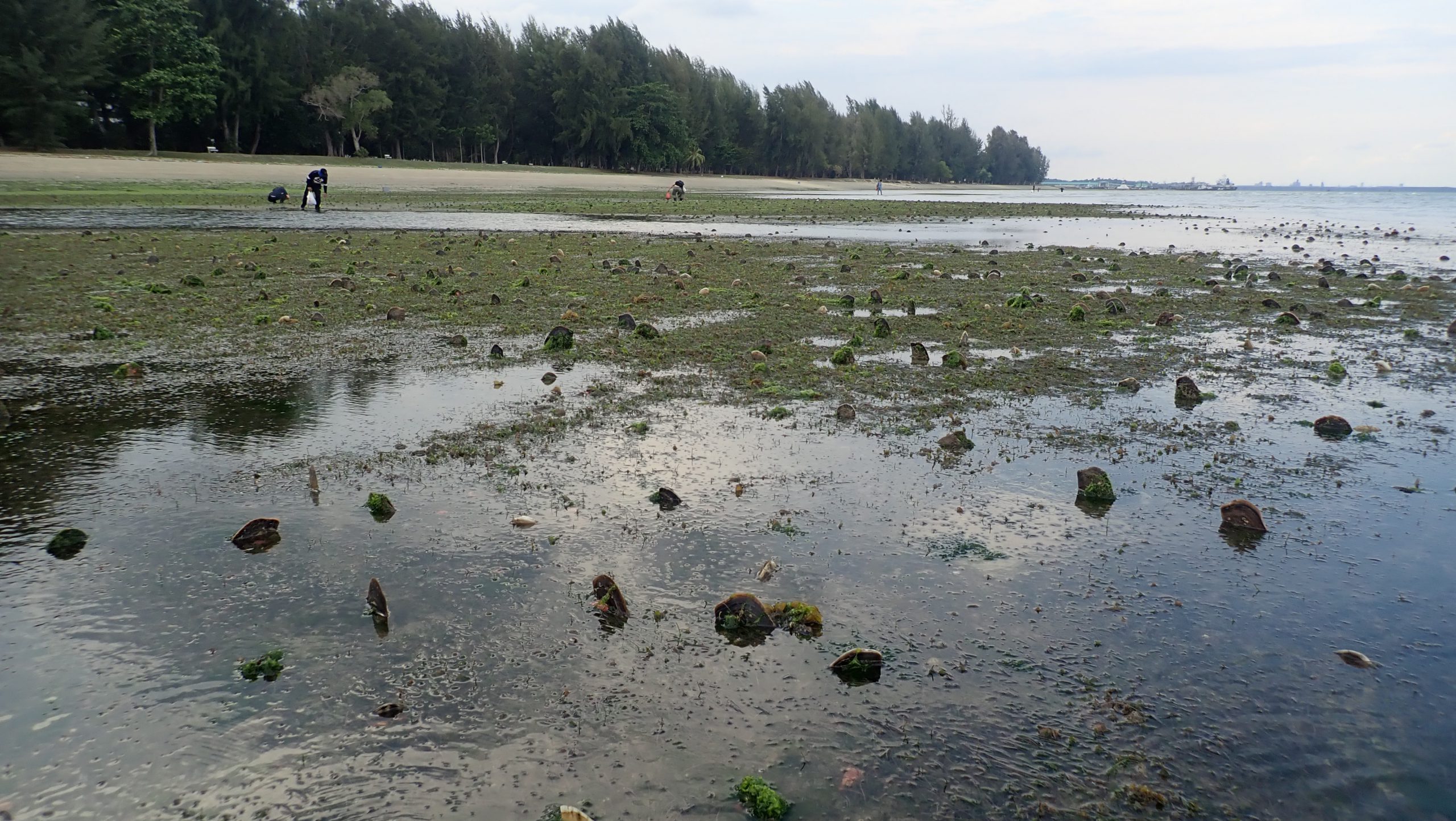
Large family of clam shells. You can see that they only have the top 2-3cm out of the substrate.
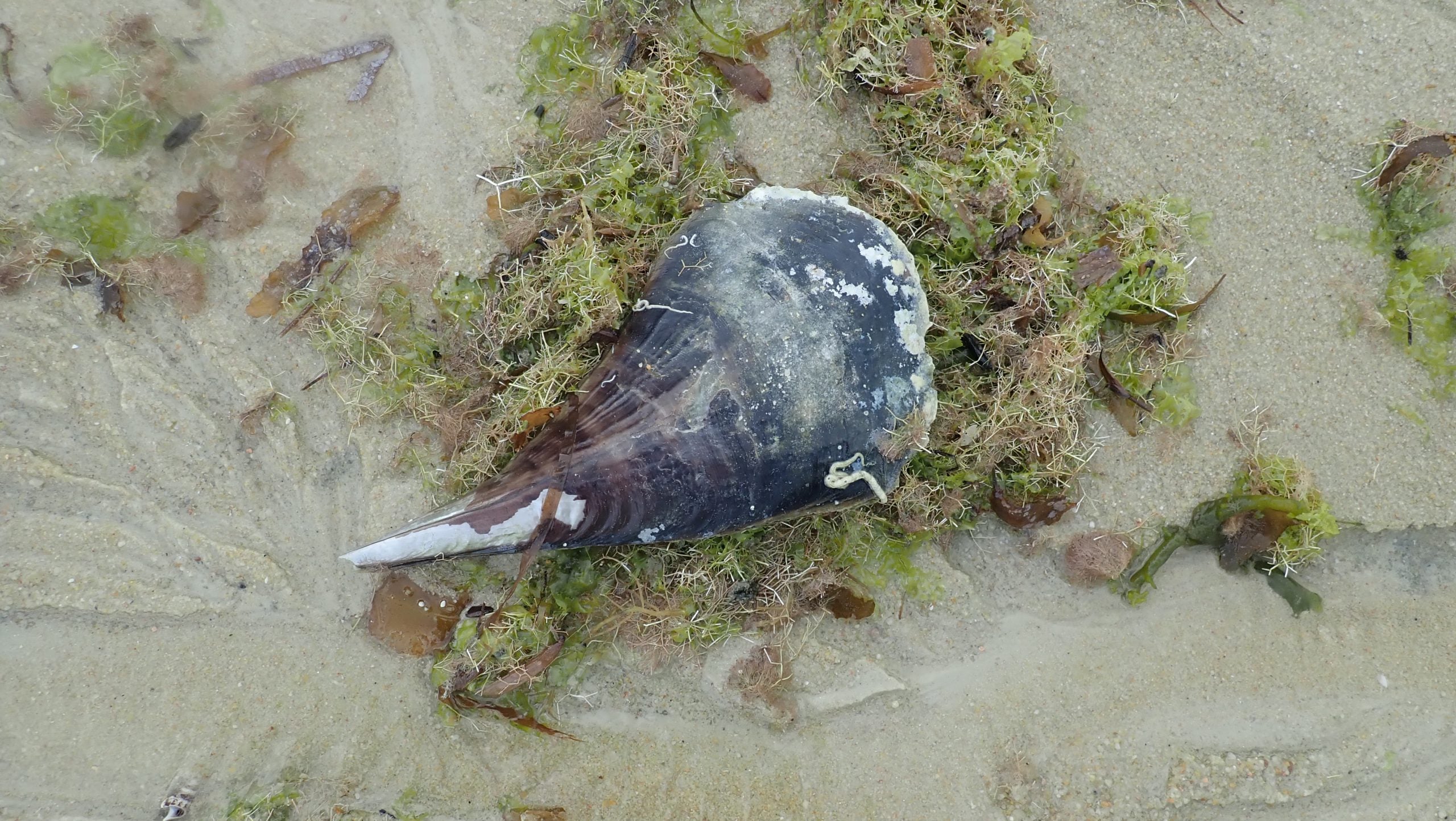
An empty fan shell.

Belachan shrimp.
Belachan Shrimp (Acetes spp)
Conservation status in Singapore: Unknown
These tiny shrimp of about only 0.8-4cm in length swarm in large numbers close to the shore. Given their small size, they filter feed mostly on algae and phytoplankton. The belachan shrimp are important in their ecosystem as they are a source of food for larger marine animals!
Belachan shrimp get their name from – you guessed it – being one of the most common ingredients in belachan, a local chilli shrimp paste! The shrimps are dried under the sun, or fermented to make cinchalok (another type of chilli shrimp sauce).
In the past, they used to occur in huge numbers and were an important source of protein for fishing villagers. However, due to human activities such as reclamation and pollution, they are not as easily found in Singapore’s shores.
Baler Shell (Melo melo)
Conservation status in Singapore: Endangered
Occasionally seen on the northern shores of Singapore, they occur on sandy and muddy substrates near mangroves and seagrasses. They are usually found in deeper sublittoral waters, but occasionally seen washed onto the shore. The melon shaped shell has a very striking body pattern of brown with white stripes, while its foot is pale on the underside. They have a pair of slender tentacles, a long proboscis and a very long siphon that sticks out at the front of the shell. They can grow up to 25cm in length! Traditionally, these large shells were used to bale water from boats (such as sampans), and that is how they got their name.
Baler shells are predators. They hunt and feed on other snails and bivalves, moving around the surface of the substrate in search of their prey. Once they find their prey, they use their foot to quickly envelop it completely, slowly suffocating it! They maintain this posture until the prey is forced to open its shell to breathe or suffocate, and the baler shell then consumes its prey, leaving just an empty shell behind!
The baler shell is highly endangered due to harvesting and habitat loss. The baler shell was initially “thought to have been exterminated from our waters, but a recent isolated sighting confirms their continued presence” (Singapore Red Data Book 1994). Other than consumption of their flesh, they are very popular due to their decorative shell. They are also still used in some markets to measure out sugar, salt and flour!
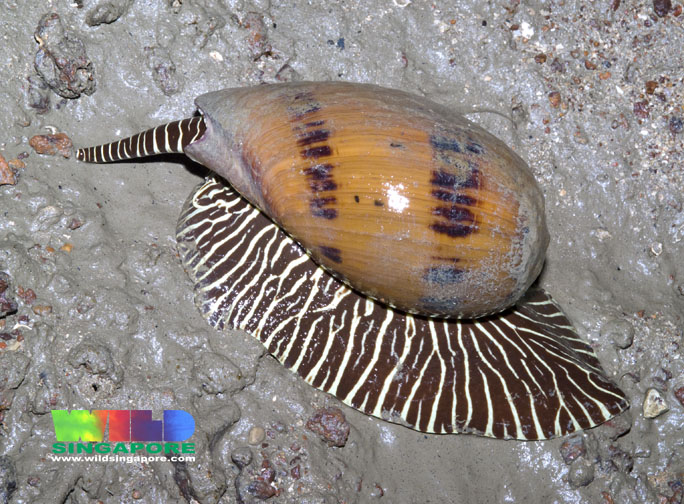
Baler shell. You can see the brown body with white stripes and its long proboscis.
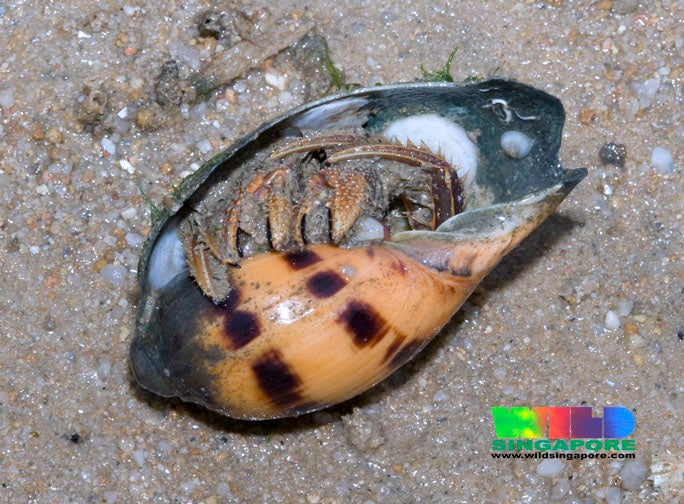
Orange-striped hermit crab (Clibanarius infraspinatus) in baler shell. The empty shell serves as a home for other organisms in the environment.
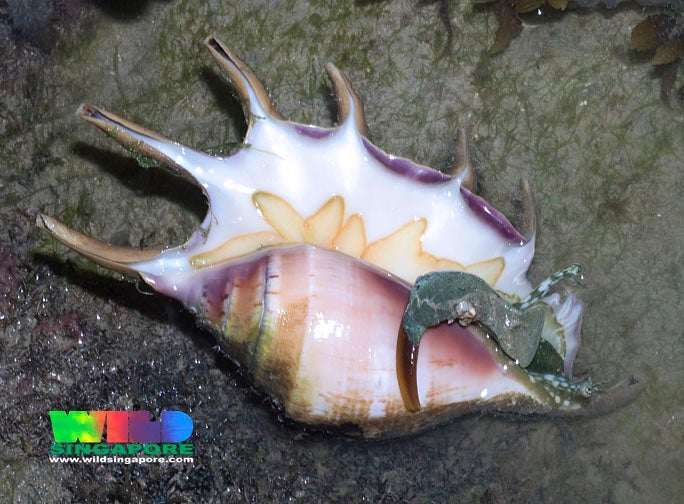
Underside of a spider conch.
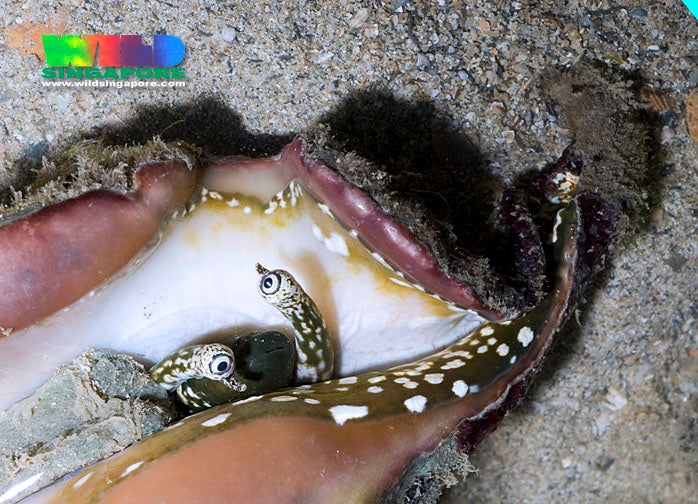
Close up of a spider conch. You can see its eye stalks!
Spider Conch (Lambis lambis)
Conservation status in Singapore: Vulnerable
Once abundant in the 1960s, the spider conch has a very distinctive shape: it has 6 long spider-like spines on its side, which its name is derived from! Often spotted in the southern shores of Singapore especially near coral rubble areas, the spider conch moves about in a vaulting-like manner. The spines help to stabilise it and prevents the conch from toppling over as it ‘hops’ along.
When the spider conch is still, is not easy to spot – its dorsal surface and margins are often encrusted with a thick layer of algae and other detritus! It’s underside is glossy pink, with a yellow or orange colouration. Its body is olive-brown, and mottled with white spots. It has human-like eyes at the end of its tentacles which provide good vision for the conch to see where it is ‘hopping’ to. It also has a thick siphon and a hook-like operculum attached to a long and strong foot which it uses to ‘hop’. It can grow up to 20cm long. The spines that give the spider conch its name are only found in adults. The shell of male spider conches are usually smaller and have shorter spines than the those in the female.
The spider conch is a grazer, feeding on fine red algae. It is considered a delicacy in many parts of South East Asia, and their shells are prized by many collectors, especially when polished. They were probably heavily harvested in Singapore in the past, contributing to their low numbers today. Just like other marine organisms found around Singapore’s shores, the local population of spider conches are also affected by habitat degradation. Given their ability to camouflage in their environment so well, they are also easily susceptible to trampling by careless visitors to the shores.
Top Shell (Tectus niloticus)
Conservation status in Singapore: Vulnerable
Conical in shape with a flat base, top shells resemble the toys of the past – spinning tops! Growing up to 15cm in side, they have distinctive red markings on their shell – but this colouration is often obscured by encrusting animals. Once abundant in the 1960s, top shells are now less common before. However, they can still be found at the southern shores of Singapore, especially in the rocky shores. They also hang around seawalls! They are not well adapted to dry conditions, so are mostly found close to the low water mark during low tide.
Top shells are grazers – they mainly eat filamentous algae on rocks, avoiding sandy bottoms and living corals. They (along with many other species of snails) are equipped with a special row of teeth known as the radula, which work like a conveyor belt. The radula scrapes or rasps the algae off the rocks and takes them into their mouth. This leaves a very distinctive feeding mark due to the unique structure of the radula.
Top shells are harvested not only for their meat, but for their shells as well. Before plastic, the most durable buttons came from top shells. They were often collected, then polished to remove its rather dull looking outer shell layer. This will reveal the “mother-of-pearl” nacreous layer underneath, and buttons would be cut out from the tough shell. As a result, they are one of the most economically important snails in the Pacific and Indo-Pacific regions, which has led to severe overfishing and its depletion in the wild. Many policies have been put in place to manage the harvesting of top shells. There are also attempts to culture them for food and to restock wild populations. Other than overfishing, top shells are also affected by human activities such as reclamation and pollution.
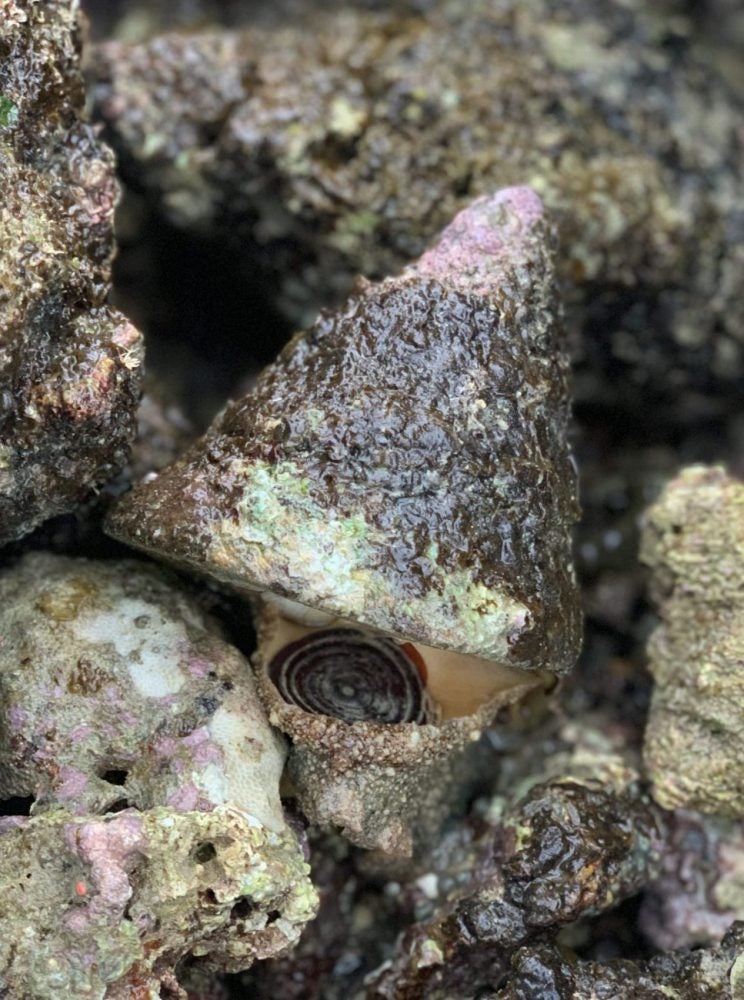
Giant top shell. You can see its brown operculum with concentric rings that functions as a trapdoor, allowing the snail to retract into the shell.
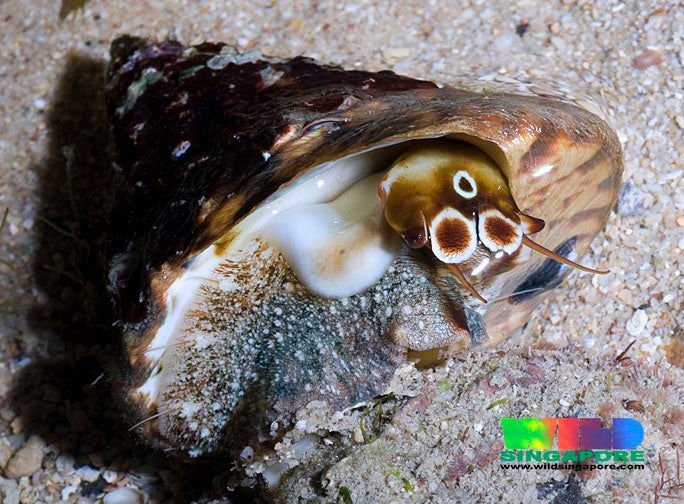
Close up of the underside of a top shell. You can see its head tentacles and eyes!
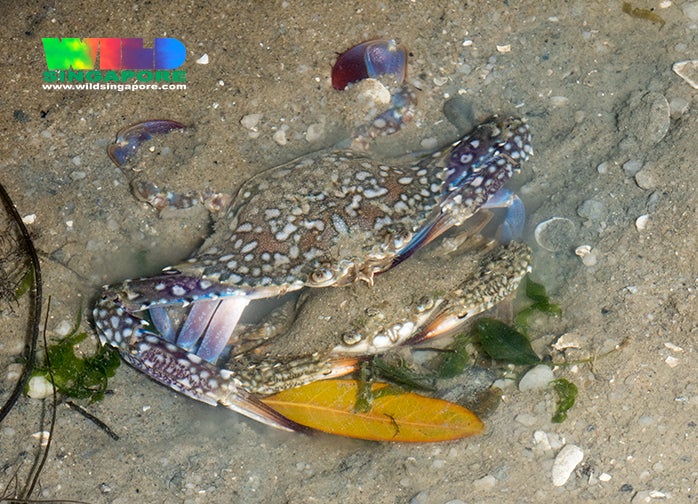
Flower crabs caught mating. The male is the highly decorative, blue crab, and the female is the dull green crab.
Flower Crab (Portunus pelagicus)
Conservation status in Singapore: Not Assessed
Also known as blue swimmer crabs, flower crabs are commonly found on many of Singapore’s shores, especially the northern shores. They are often associated with seaweed and seagrass habitats. Should the flower crab get trapped in a pool of water during low tide, it will bury itself in the substrate to avoid being spotted, leaving just its eyes above the sand or mud. Their common name, ‘blue swimmer crab’, comes from their last pair of legs that are shaped like paddles and can rotate, allowing them to swim well, and the males are blue in colour. The other common name, ‘flower crab’, is due to their attractive patterns on their bodies. However, only males are blue and have decorative patterns, while females are camouflaged with the environment, and occur in a dull green with less distinct patterns.
Flower crabs are predators – they are known to hunt small fish, worms, small crabs and shrimp, and molluscs, often ambushing their prey. They also occasionally eat algae and seagrass. They are an important food source for other bigger animals in the ecosystem, such as fish and birds.
Flower crabs are a popular seafood in Singapore and they are still caught in our shores with baited traps and nets. Whilst their numbers are still relatively high, they can be affected by human activities such as pollution, land reclamation and overfishing.
Without biodiversity, we would not have the food that we eat today. But many of the animals that used to be abundant in Singapore in the past – as recent as the 1960s – are slowly disappearing before our eyes. We need to act now in order to preserve our marine biodiversity and to ensure that our future generations will still be able to enjoy seeing the animals that we see today.
Sources
Ng, Peter K. L. and Wang Luan Keng and Kelvin K. P. Lim, 2008. Private Lives: An Expose of Singapore’s Mangroves. The Raffles Museum of Biodiversity Research. 249 pp.
Ng, P. K. L. and Y. C. Wee, 1994. The Singapore Red Data Book: Threatened plants and animals of Singapore. The Nature Society (Singapore), Singapore. 343 pp.
Palomares, M.L.D. and D. Pauly., 2019. SeaLifeBase. [www.sealifebase.org]. Accessed 18 May 2019.
Tan, K. S. & L. M. Chou, 2000. A Guide to the Common Seashells of Singapore. Singapore Science Centre, Singapore. 160 pp.
Tan, Leo W. H. & Ng, Peter K. L., 1988. A Guide to Seashore Life. The Singapore Science Centre, Singapore. 160 pp.
Tan, Ria, 2019. Wild Singapore. [http://www.wildsingapore.com/]. Accessed 17 May 2019.
Yeo, Ron. 2013. Prawns (Phylum Arthropoda: Suborder Dendrobranchiata) of Singapore. [http://tidechaser.blogspot.com/2013/06/prawns-penaeidae-dendrobranchiata.html]. Accessed 17 May 2019.


